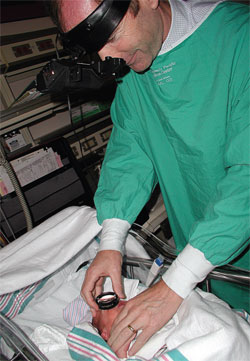 An eye exam is all it takes to identify those infants most likely to benefit from early treatment for retinopathy of prematurity (ROP), according to new findings from the Early Treatment for Retinopathy of Prematurity (ETROP) study. These results were published online in the April Archives of Ophthalmology.
An eye exam is all it takes to identify those infants most likely to benefit from early treatment for retinopathy of prematurity (ROP), according to new findings from the Early Treatment for Retinopathy of Prematurity (ETROP) study. These results were published online in the April Archives of Ophthalmology.
“The long-term study has given clinicians evidence that infants with ROP should be treated with different strategies based on an infant’s risk for a severe form of the disease, which can be determined through an exam at the bedside,” says study chair William V. Good, M.D.
Nine-month results from the ETROP study, published in 2003, found that only those infants with type 1 ROP (dilated or twisted blood vessels in the retina and substantial growth of new blood vessels) benefited from early treatment. Those with type 2 ROP (more moderate amount of new blood vessel growth) didn’t benefit from early treatment.
Researchers then followed the same 370 children until they were six years old. The results from 2003 were confirmed. Of the eyes with type 1 ROP that were treated early, 75% were spared legal blindness, compared with 67% of those treated at the standard time. Of the type 2 eyes that were monitored according to standard protocol, more than half improved with no treatment.
But, promising as these results are, more research and improvement is needed. “Unfortunately, not all eyes selected for early treatment do well,” says Robert J. Hardy, Ph.D., director of the ETROP study coordinating center. “Additional research is needed to identify still better methods for the prevention and treatment of severe ROP.”
Christiansen SP, Dobson V, Quinn GE, et al. Progression of type 2 to type 1 retinopathy of prematurity in the Early Treatment for Retinopathy of Prematurity Study. Arch Ophthalmol. 2010 Apr;128(4):461-5.











